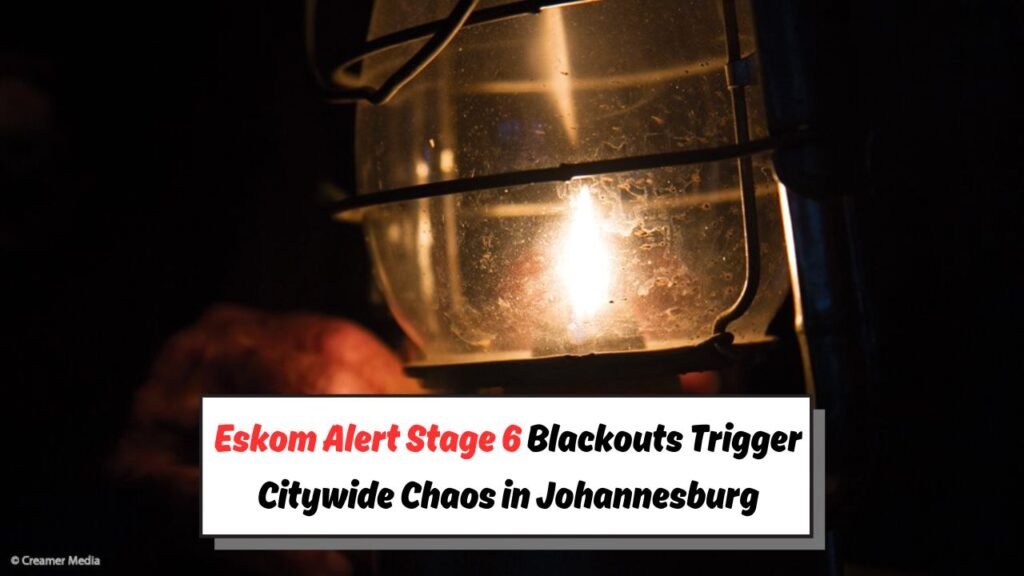Stage 6 Load Shedding Nightmare: As Johannesburg gears up for a challenging week ahead, residents are expressing growing concern over the return of Stage 6 load shedding. This dreaded stage of power cuts has made a comeback, casting a shadow over the city known for its vibrancy and economic significance. The impact of Stage 6 load shedding is not just a matter of inconvenience; it poses serious challenges to businesses, disrupts daily life, and places immense pressure on the energy infrastructure. With power outages lasting up to six hours at a time, many are bracing themselves for what could be Johannesburg’s darkest week in recent memory.

Understanding Stage 6 Load Shedding and Its Impact on Johannesburg
The return of Stage 6 load shedding in Johannesburg is a stark reminder of the ongoing energy crisis in South Africa. At this level, Eskom, the national power utility, is forced to shed approximately 6,000 megawatts from the national grid, resulting in widespread power outages. This drastic measure is implemented to prevent a total collapse of the power system. For Johannesburg, a city that relies heavily on a stable power supply to fuel its industries, the implications are severe. Businesses are finding it increasingly difficult to maintain operations, with some even resorting to costly backup generators to keep the lights on. Moreover, the knock-on effects on the economy are significant, as productivity takes a hit, and consumer confidence wanes. The city’s residents, too, are feeling the strain, as they grapple with interruptions to their daily routines and increased safety concerns during periods of darkness.
How Johannesburg Residents Are Coping with Stage 6 Load Shedding
In response to the ongoing Stage 6 load shedding, Johannesburg’s residents are adopting a range of strategies to mitigate the impact of power outages. Many households are investing in alternative energy solutions such as solar panels and inverters to ensure a continuous power supply. This shift not only provides a degree of independence from the national grid but also promotes the use of renewable energy. Additionally, some communities are banding together, forming neighborhood watch groups to enhance security during blackout periods. On a more individual level, people are becoming more resourceful, using battery-powered devices and embracing energy-saving practices to conserve electricity. Local businesses, in turn, are adjusting their operational hours to align with load shedding schedules and are increasingly turning to remote work arrangements to maintain productivity. Despite the challenges, the resilience and adaptability of Johannesburg’s residents are shining through, as they navigate this difficult period with determination and creativity.
The Role of Eskom in Addressing the Load Shedding Crisis
Eskom, South Africa’s state-owned power utility, plays a crucial role in managing the load shedding crisis. The utility’s aging infrastructure and maintenance backlogs have been significant contributors to the current energy situation. To address these issues, Eskom is implementing several measures aimed at stabilizing the grid and reducing the frequency and severity of load shedding. These include increasing maintenance on existing power plants, investing in new infrastructure projects, and exploring alternative energy sources. Additionally, Eskom is working on improving its communication with the public, providing more accurate and timely information regarding load shedding schedules. While these efforts are ongoing, there is a growing call for more comprehensive reforms within the utility to address the root causes of the energy crisis and ensure a more reliable power supply for Johannesburg and the rest of South Africa.
Looking Ahead: The Future of Load Shedding in Johannesburg
As Johannesburg faces another week of Stage 6 load shedding, the question on everyone’s mind is whether the situation will improve in the near future. The answer lies in a combination of short-term interventions and long-term strategies. In the immediate term, Eskom’s focus remains on stabilizing the power grid and minimizing disruptions. However, the long-term solution requires a more sustainable approach, involving significant investment in renewable energy and strengthening the power infrastructure. Policymakers are increasingly advocating for a diversified energy mix, reducing reliance on coal and embracing greener alternatives such as wind and solar power. Additionally, there is a push for greater collaboration between the public and private sectors to drive innovation and investment in the energy sector. While the path forward is challenging, the resilience and ingenuity of Johannesburg’s residents, combined with strategic reforms, offer hope for a future where load shedding becomes a thing of the past.
How is Johannesburg preparing to handle the return of stage 6 load shedding?
Johannesburg is bracing for its darkest week amidst the load shedding nightmare.
What impact does stage 6 load shedding have on Johannesburg residents?
 South Africa Faces Crisis: 150,000 Students Affected by NSFAS Payment Delays in August 2025
South Africa Faces Crisis: 150,000 Students Affected by NSFAS Payment Delays in August 2025
Residents face power outages and disruptions affecting daily life.


